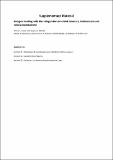Halogen bonding with the halogenabenzene bird structure, halobenzene and halocyclopentadiene
Abstract
The ability of the “bird-like” halogenabenzene molecule, referred to as X-bird (X= Cl to At), to form halogen-bonded complexes with the nucleophiles H2O and NH3 was investigated using double-hybrid density functional theory and the aug-cc-pVTZ/aug-cc-pVTZ-PP basis set. The structures and interaction energies were compared with 5-halocyclopenta-1,3-diene (halocyclopentadiene; an isomer of halogenabenzene) and halobenzene, also complexed with H2O and NH3. The unusual structure of the X-bird, with the halogen bonded to two carbon atoms, results in two distinct σ-holes, roughly at the extension of the C-X bonds. Based on the behaviour of the interaction energy (which increases for heavier halogens) and van der Waals (vdW) ratio (which decreases for heavier halogens), it is concluded that the X-bird forms proper halogen bonds with H2O and NH3. The interaction energies are larger than those of the halogen-bonded complexes involving halobenzene and halocyclopentadiene, presumably due to the presence of a secondary interaction.
Citation
Cates , E L & van Mourik , T 2019 , ' Halogen bonding with the halogenabenzene bird structure, halobenzene and halocyclopentadiene ' , Journal of Computational Chemistry , vol. 40 , no. 24 , pp. 2111-2118 . https://doi.org/10.1002/jcc.25863
Publication
Journal of Computational Chemistry
Status
Peer reviewed
ISSN
0192-8651Type
Journal article
Description
We thank EastCHEM for support via the EaStCHEM Research Computing Facility. The research data supporting this publication cab be accessed at https://doi.org/10.17630/a3b1f172-dd54-4df1-a498-9951cfce9cee.Collections
Items in the St Andrews Research Repository are protected by copyright, with all rights reserved, unless otherwise indicated.

